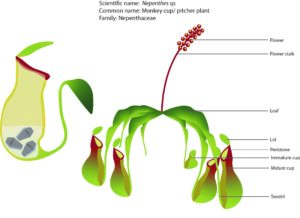
Aloe you vera much
Aloe vera is one of the few plants that share the same scientific and common name. It is a flowering plant that originates from Northern Africa under the family of Aloaceae, which was previously placed under the lily family (Liliaceae). Aloe vera is a xerophyte, a plant that can grow in arid conditions and can withstand long periods of drought. This adaptation includes waxy leaves, the ability to store water, leaves reduced to spines to […]
Read More
Nepenthes – not your “cup” of tea
If you think about a cup in nature, what comes to your mind? The monkey cup is a good call, as a carnivorous plant, scientifically referred to as Nepenthes sp., it is unique because of its modified cup-shaped leaf that looks like a small vase with a lid. Some people use the cup as a container to cook sticky rice added with coconut. Travelers often use older pitchers as water scoops or to catch rainwater. […]
Read More
Venus flytrap – don’t fall into the “trap”!
Venus flytrap (Dionaea muscipula) is the most exciting and popular among all carnivorous plants as it has modified leaves as snap traps. It is under the family of Droseraceae and the only species in its genus. Venus flytraps are native only to the coastal plain of southeastern North Carolina and extreme northeastern South Carolina. It can be found the area with unfavorable conditions such as peaty and acidic soil mostly low nutrient availability in damp […]
Read MorePhotosynthesis Explained
View, browse, and/or download material for educational and temporary copying purposes only.
Read MoreWhy study plants?
View, browse, and/or download material for educational and temporary copying purposes only.
Read MorePlants are photosynthetic, multicellular and terrestrial creatures
View, browse, and/or download material for educational and temporary copying purposes only.
Read MorePlant Micronutrients and Metals
View, browse, and/or download material for educational and temporary copying purposes only.
Read MoreTrends of Producing coronavirus vaccine using Tobacco Plants
Before the commercialized vaccine was introduced, people mostly use traditional ways such as medicinal plants to battle infectious diseases. Plants that have antibiotic properties such as ginger, echinacea kill some pathogens and benefit the immune system. But using plants as vaccine factories is a relatively new idea because plants do not produce pathogens or human proteins. Not until plant genetic engineering technologies have been in the playing for the past 3 decades which allows foreign […]
Read More